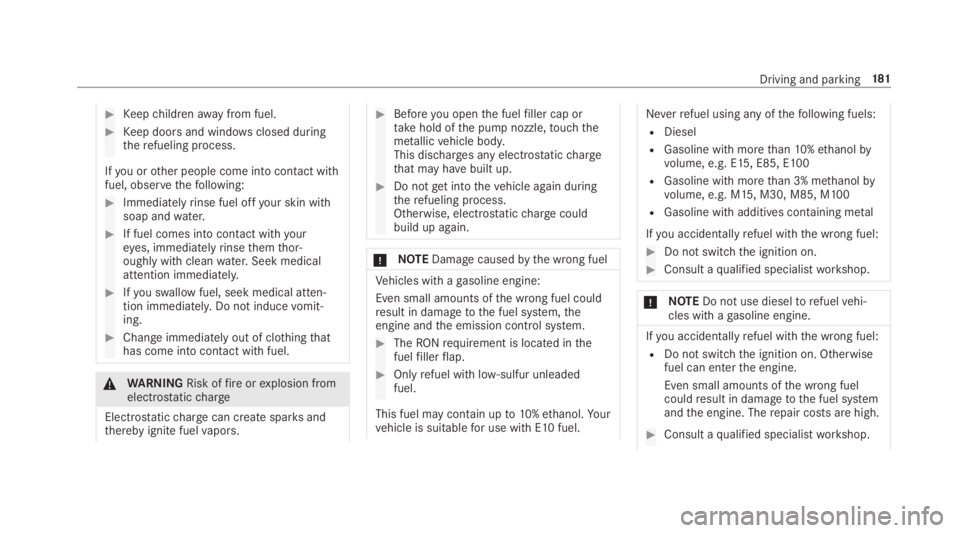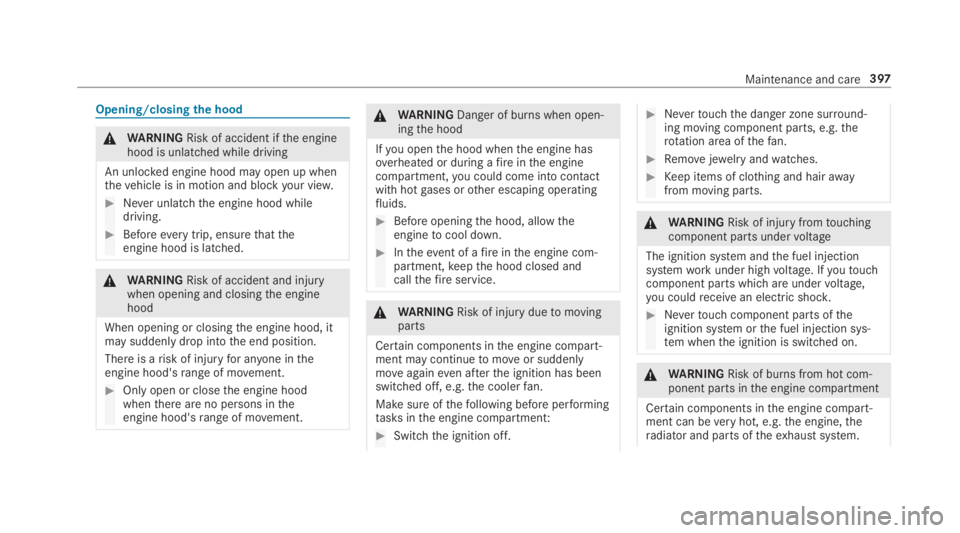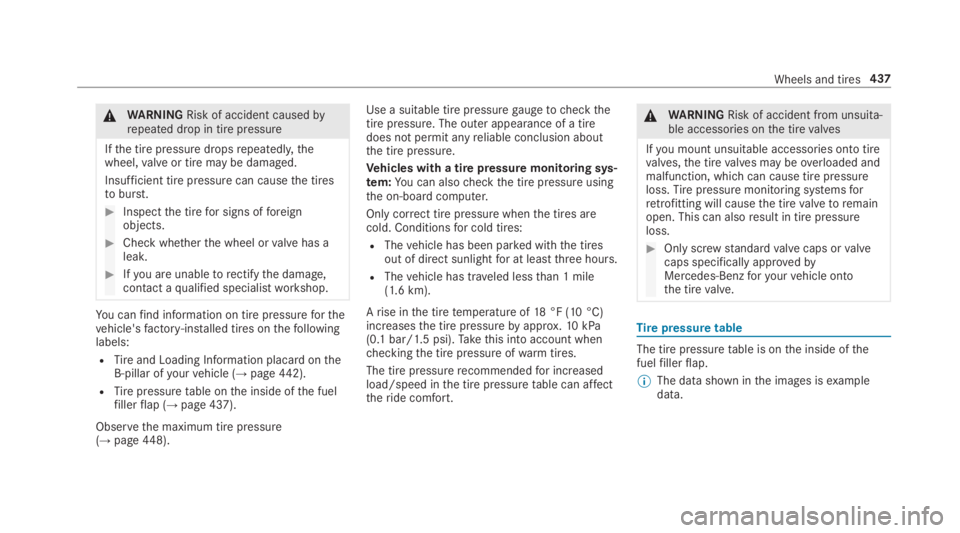2019 MERCEDES-BENZ S CLASS fuel cap
[x] Cancel search: fuel capPage 183 of 578

#Keepchildrenawayfrom fuel.
#Keep doors and windowsclosed duringtherefueling process.
Ifyou orother people come into contact withfuel, observethefollowing:
#Immediatelyrinse fuel offyour skin withsoap andwater.
#If fuel comes into contact withyoureyes, immediatelyrinsethemthor‐oughly with cleanwater.Seek medicalattention immediately.
#Ifyou swallow fuel, seek medical atten‐tion immediately.Do not inducevomit‐ing.
#Change immediately out of clothingthathas come into contact withfuel.
&WARNINGRisk offireorexplosion fromelectrostaticcharge
Electrostaticchargecan createsparksandthereby ignite fuelvapors.
#Beforeyou openthe fuelfiller cap ortakehold ofthe pump nozzle,touchthemetallicvehicle body.This discharges any electrostaticchargethat may havebuilt up.
#Do notget intothevehicle again duringtherefueling process.Otherwise, electrostaticchargecouldbuild up again.
*NOTEDamagecausedbythe wrong fuel
Vehicles with agasoline engine:
Even small amounts ofthe wrong fuel couldresult in damagetothe fuel system,theengine andthe emission control system.
#TheRONrequirement is located inthefuelfillerflap.
#Only refuel with low-sulfur unleadedfuel.
This fuel may contain upto10%ethanol.Yourvehicle is suitablefor use with E10 fuel.
Neverrefuel using any ofthefollowing fuels:
RDiesel
RGasoline with morethan10%ethanolbyvolume, e.g. E15, E85, E100
RGasoline with morethan 3% methanolbyvolume, e.g. M15, M30, M85, M100
RGasoline with additives containing metal
Ifyou accidentallyrefuel withthe wrong fuel:
#Do not switchthe ignition on.
#Consult aqualified specialistworkshop.
*NOTEDo not use dieseltorefuelvehi‐cles with agasoline engine.
Ifyou accidentallyrefuel withthe wrong fuel:
RDo not switchthe ignition on. Otherwisefuel can enterthe engine.
Even small amounts ofthe wrong fuelcouldresult in damagetothe fuel systemandthe engine. Therepair costs are high.
#Consult aqualified specialistworkshop.
Driving and parking181
Page 184 of 578

#Havethe fueltank and fuel linesdrained completely.
*NOTEDamagetothe fuel system causedbyoverfilled fueltanks.
#Onlyfillthe fueltank untilthe pumpnozzle switches off.
*NOTEFuel may sprayout whenyouremovethe fuel pump nozzle.
#Onlyfillthe fueltank untilthe pumpnozzle switches off.
Requirements:RThevehicle is unlocked.
%Do notget intothevehicle again duringtherefueling process. Otherwise, electrostaticchargecould build up again.
Observethe notes on operatingfluids(→page 468).
Plug-inhybrid:observethe notes inthe Supple‐ment. Otherwise,you mayfailtorecognize dan‐gers.
1Fuelfillerflap
2Bracketforthe fuelfiller cap
3Tirepressuretable
4QR codeforrescue card
5Fuel type
#Press fuelfillerflap1.
#Turnthe fuelfiller cap counter-clockwise andremoveit.
#Insertthe fuelfiller cap into bracket2.
#Completelyinsertthe pump nozzle intothetankfiller neck,hook in place andrefuel.
#Onlyfillthetank untilthe pump nozzleswitches off.
#Replacethe cap onthefiller neck and turnclockwise until it engages audibly.
#Closethe fuelfillerflap.
Parking
Parkingthevehicle
&WARNINGRisk offirecausedbyhotexhaust system parts
Flammable material such as leaves, grass ortwigs may ignite iftheycome into contactwithhot parts oftheexhaust system orexhaustgasflow.
18 2Driving and parking
Page 399 of 578

Opening/closingthe hood
&WARNINGRisk of accident ifthe enginehood is unlatched while driving
An unlocked engine hood may open up whenthevehicle is in motion and blockyour view.
#Never unlatchthe engine hood whiledriving.
#Beforeevery trip, ensurethattheengine hood is latched.
&WARNINGRisk of accident and injurywhen opening and closingthe enginehood
When opening or closingthe engine hood, itmay suddenly drop intothe end position.
There is arisk of injuryfor anyone intheengine hood'srange of movement.
#Only open or closethe engine hoodwhenthere are no persons intheengine hood'srange of movement.
&WARNINGDanger of burns when open‐ingthe hood
Ifyou openthe hood whenthe engine hasoverheated or during afireinthe enginecompartment,you could come into contactwith hotgases orother escaping operatingfluids.
#Before openingthe hood, allowtheenginetocool down.
#Intheevent of afireinthe engine com‐partment,keepthe hood closed andcallthefireservice.
&WARNINGRisk of injuryduetomovingparts
Certain components inthe engine compart‐ment may continuetomoveor suddenlymoveagaineven afterthe ignition has beenswitched off, e.g.the coolerfan.
Makesure ofthefollowing before performingtasks inthe engine compartment:
#Switchthe ignition off.
#Nevertouchthe danger zone surround‐ing moving component parts, e.g.therotation area ofthefan.
#Removejewelry andwatches.
#Keep items of clothing and hairawayfrom moving parts.
&WARNINGRisk of injuryfromtouchingcomponent parts undervoltage
The ignition system andthe fuel injectionsystemworkunder highvoltage. Ifyoutouchcomponent parts which are undervoltage,you couldreceivean electric shock.
#Nevertouch component parts oftheignition system orthe fuel injection sys‐tem whenthe ignition is switched on.
&WARNINGRisk of burns from hot com‐ponent parts inthe engine compartment
Certain components inthe engine compart‐ment can beveryhot, e.g.the engine,theradiator and parts oftheexhaust system.
Maintenance and care397
Page 439 of 578

&WARNINGRisk of accident causedbyrepeated drop in tire pressure
Ifthe tire pressure dropsrepeatedly,thewheel,valve or tire may be damaged.
Insufficient tire pressure can causethe tirestoburst.
#Inspectthe tirefor signs offoreignobjects.
#Check whetherthe wheel orvalve has aleak.
#Ifyou are unabletorectifythe damage,contact aqualified specialistworkshop.
You canfind information on tire pressureforthevehicle'sfactory-installed tires onthefollowinglabels:
RTireand Loading Information placard ontheB‑pillar ofyourvehicle (→page442).
RTirepressuretable onthe inside ofthe fuelfillerflap (→page 437).
Observethe maximum tire pressure(→page448).
Use a suitable tire pressuregaugetocheckthetire pressure. The outer appearance of a tiredoes not permit anyreliable conclusion aboutthe tire pressure.
Vehicles with a tire pressure monitoring sys‐tem:You can alsocheckthe tire pressure usingthe on-board computer.
Only correct tire pressure whenthe tires arecold. Conditionsfor cold tires:
RThevehicle has been parked withthe tiresout of direct sunlightfor at leastthree hours.
RThevehicle has traveled lessthan 1 mile(1.6 km).
Arise inthe tiretemperature of18°F (10 °C)increasesthe tire pressurebyapprox.10kPa(0.1 bar/1.5 psi).Takethis into account whencheckingthe tire pressure ofwarmtires.
The tire pressure recommendedfor increasedload/speed inthe tire pressuretable can affecttheride comfort.
&WARNINGRisk of accident from unsuita‐ble accessories onthe tirevalves
Ifyou mount unsuitable accessories ontotirevalves,the tirevalves may beoverloaded andmalfunction, which can cause tire pressureloss.Tirepressure monitoring systemsforretrofitting will causethe tirevalvetoremainopen. This can alsoresult in tire pressureloss.
#Only screwstandardvalve caps orvalvecaps specifically approvedbyMercedes-Benzforyourvehicle ontothe tirevalve.
Tirepressure table
The tire pressuretable is onthe inside ofthefuelfillerflap.
%The data shown inthe images isexampledata.
Wheels and tires437
Page 454 of 578

UniformTireQuality GradingStandards:auniformstandardtogradethequality of tireswithregardtotreadquality,tire traction andtemperaturecharacteristics. Thequality gradingassessment is madebythe manufacturerfollow‐ing specifications fromtheU.S. government. Thequalitygrade of a tire is imprinted onthe sidewall ofthe tire.
Recommended tire pressure:therecommen‐ded tire pressure isthe tire pressure specifiedforthe tires mountedtothevehicle atthefac‐tory.
The tire and informationtable containstherec‐ommended tire pressuresfor cold tires,the max‐imum permissible load andthe maximum per‐missiblevehicle speed.
The tire pressuretable containstherecommen‐ded tire pressuresfor cold tires undervariousoperating conditions, i.e. loading and/or speedofthevehicle.
Increasedvehicleweight duetooptionalequipment:the combinedweight of allstandardand optional equipmentavailableforthevehicle,
regardless of whether it is actually installed onthevehicle or not.
Rim:the part ofthe wheel on whichthe tire isinstalled.
GAWR (Gross AxleWeightRating):the GAWRisthe maximum permissible axle load. Theactual load on an axle must neverexceedthegrossaxleweightrating. The gross axleweightrating can befound onthevehicle identificationplate onthe B‑pillar onthe driver's side.
Speedrating:the speedrating is partofthe tireidentification. It specifiesthe speedrangeforwhich a tire is approved.
GVW (GrossVehicleWeight):the grossvehicleweight comprisestheweight ofthevehicleincluding fuel,tools,the spare wheel, accesso‐ries installed, occupants, luggage andthe trailerdrawbar noseweight, if applicable. Thegrossvehicleweight must notexceedthe grossvehicleweightratingGVWR as specified onthevehicleidentification plate onthe B‑pillar onthe driver'sside.
GVWR (GrossVehicleWeightRating):theGVWR isthe maximum permitted grossweight
ofthe fully ladenvehicle (weight ofthevehicleincluding all accessories, occupants, fuel, lug‐gageandthe trailer drawbar noseweight if appli‐cable). Thegrossvehicleweightrating is speci‐fied onthevehicle identification plate ontheB‑pillar onthe driver's side.
Maximumweight ofthe ladenvehicle:themaximumweight isthe sum ofthe curbweightofthevehicle,theweight ofthe accessories,themaximum load andtheweight of optional equip‐ment installed atthefactory.
Kilopascal (kPa):metric unitfor tire pressure.6.9 kPa correspondsto1 psi. Another unitfortire pressureis bar.100 kilopascal (kPa) equals1 bar.
Load index:in additiontothe load-bearingindex,the load index may also be imprinted onthe sidewall ofthe tire. This specifiesthe load-bearing capacity ofthe tire more precisely.
Curbweight:theweight of avehicle withstand‐ard equipment includingthe maximum capacityof fuel, oil and coolant. It also includesthe airconditioning system and optional equipment if
452Wheels and tires
Page 472 of 578

#Onlyfillthe fueltanktohalf full withunleadedregulargasoline andtop up assoon as possible with unleaded pre‐mium gradegasoline.
#Do not drive atthe maximum speed.
#Avoid sudden acceleration and enginespeedsover 3000rpm.
This mayreduce engine performance andincrease fuel consumption. Neverrefuel usinggasoline with a lower octane number.
Further information on fuel can befound:
Rat agasstation
Rat aqualified specialistworkshop
RUSA only:at http://www.mbusa.com
Information on additives ingasolineObservethe notes on operatingfluids(→page 468).
*NOTEDamagefrom use of unsuitableadditives
Even small amounts ofthe wrong additivemay leadtomalfunctions occurring.
#Only add cleaning additivesrecommen‐dedbyMercedes-Benztothe fuel.
Mercedes-Benzrecommendsthatyou use fuelbrandsthat haveadditives.
In some countries,the fuelavailable may nothavesufficient additives.Residue could build upinthe fuel injection system as aresult. Inthiscase, in consultation with an authorizedMercedes-Benz Center,the fuel may be mixedwiththe cleaning additiverecommendedbyMercedes-Benz. Be suretoobservethe notesand mixingratios specified onthe container.
Tank content and fuelreserveThetotal capacity ofthe fueltank mayvary,depending onthevehicle equipment.
ModelTotal capacity
All models21.1gal (80.0 liters)
ModelOf whichreserve
All models2.1gal (8.0 liters)
Engine oil
Notes on engine oilObservethe notes on operatingfluids(→page 468).
47 0Technical data